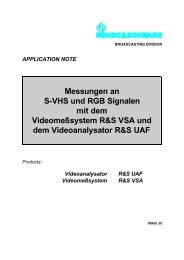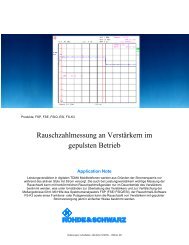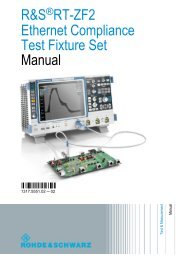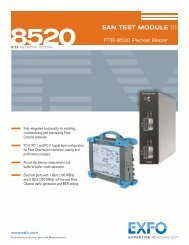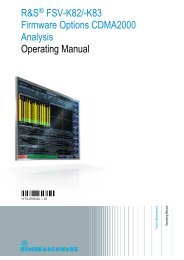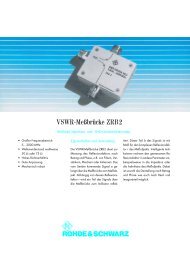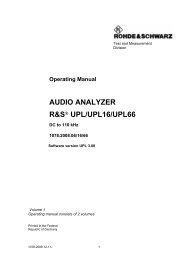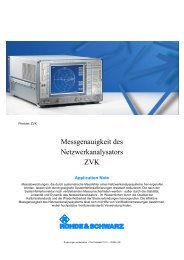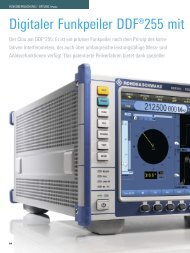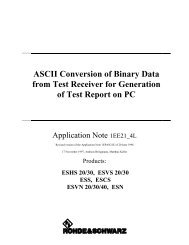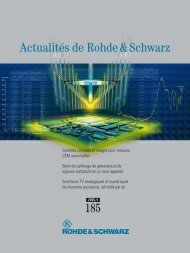EMF measurements from 100 kHz to 40 GHz ... - Rohde & Schwarz
EMF measurements from 100 kHz to 40 GHz ... - Rohde & Schwarz
EMF measurements from 100 kHz to 40 GHz ... - Rohde & Schwarz
Create successful ePaper yourself
Turn your PDF publications into a flip-book with our unique Google optimized e-Paper software.
EMC / FIELD STRENGTHMeasurement systemsReactive near field Radiated near field Far fieldLimit distance* 0 <strong>to</strong> λ λ <strong>to</strong> 2D² / λ >2D² / λE perpendicular <strong>to</strong> H? No Almost YesE, H ~ 1 / r No No YesZ F = E / H ≠ 377 Ω ≈ 377 Ω = 377 ΩTo measure E and H E or H E or HFIG 2Differences between near andfar field;* heavily dependent on thetype of transmit antenna(D = largest antenna dimension,e. g. diameter of a parabolicreflec<strong>to</strong>r).FIG 3 Configuration of the R&S ® TS-<strong>EMF</strong> with the R&S ® FSP / FSU / ESPI. FIG 4 Configuration of the R&S ® TS-<strong>EMF</strong> with the R&S ® FSH3.More information and data sheet atwww.rohde-schwarz.com(search term: TS-<strong>EMF</strong>)FIG 5The R&S ® TS-<strong>EMF</strong> with the Radio Network Analyzer R&S ® TSMU.4<strong>40</strong>64 / 10REFERENCES[1] prEN5<strong>40</strong>00, February 2002[2] Bochtler / Eidher / Wuschek: GroßräumigeErmittlung von Funkwellen in Baden-Württemberg, July 2003 (“ www.lfu.baden-wuerttemberg.de / lfu / abt3 / funkwellen”)[3] SAEFL: Mobilfunk-Basisstationen (UMTS-FDD), Messempfehlung (draft of 17 Sept.2003)[4] Radio Network Analyzer R&S ® TSMU:Performance giant in compact formatsets new standards. News <strong>from</strong><strong>Rohde</strong> & <strong>Schwarz</strong> (2003) No. 180, pp 4–7<strong>40</strong>News <strong>from</strong> <strong>Rohde</strong> & <strong>Schwarz</strong> Number 181 (2004 / I)
Measurement of UMTS emissionsWhile the construction of UMTS networksis progressing at a fast pace, norules or regulations regarding UMTS and<strong>EMF</strong> <strong>measurements</strong> were establishedyet. The Swiss Agency for the Environment,Forests and Landscape (SAEFL)is now the first civil authority <strong>to</strong> publisha measurement recommendation [3].Other countries are expected <strong>to</strong> adopt asimilar form of the measurement methodsdescribed therein.A (simplified) comparison with GSMshows the conditions of <strong>EMF</strong> <strong>measurements</strong>in UMTS emissions. With GSM,fixed frequencies are assigned <strong>to</strong> eachbase station. A continuous signal istransmitted at constant power at one ofthese frequencies, which makes it possible<strong>to</strong> simply extrapolate <strong>to</strong> the maximumfield strength generated by a basestation. The measured field strengthcan be assigned <strong>to</strong> the base station bymeans of the frequency.In the case of UMTS, however, all basestations of a network opera<strong>to</strong>r transmitat the same frequency. The basestations are differentiated by means ofscrambling codes with which each basestation encodes its own signal. With thistype of coding, the signal is simultaneouslyspread, creating a noiselike signalwith a bandwidth of 5 MHz. The transmissionpower depends on the amoun<strong>to</strong>f transmitted data and is betweenapprox. 10% for the organization channelsand the maximum output power atfull capacity utilization.Frequency-selective measurementwith UMTSFrequency-selective <strong>measurements</strong>,which are standard practice for measuringelectromagnetic fields in the environment,can also be performed for UMTS –but with the following restrictions:◆ Assignment <strong>to</strong> a base station notpossible◆ Statement only regarding themomentary value◆ Restricted sensitivity caused by abroadband, noiselike signalThe <strong>measurements</strong> obtain only the currentsummed value of all UMTS basestations in the vicinity. The worst-casescenario for extrapolation <strong>to</strong> the maximumpossible field strength presupposesthat only the organization channelswere active at the time of the measurement.However, the result of thisextrapolation can be as much as 10 dB<strong>to</strong>o high if data was also transmitted atthe time of the measurement. This measurementuncertainty can be minimizedby performing long-term <strong>measurements</strong>with the R&S ® TS-<strong>EMF</strong>.The measurement is made using theRMS detec<strong>to</strong>r and at a signal-matchedbandwidth. Channel power measurementmust be set if the Spectrum AnalyzerR&S ® FSH3 is used. The measurementparameters for UMTS ares<strong>to</strong>red in a predefined measurementpacket that comes with the test system.<strong>Rohde</strong> & <strong>Schwarz</strong> verified the measurement-packetsettings on real and syntheticUMTS signals.Code-selective measurementwith UMTSUMTS emissions must be decoded soas <strong>to</strong> avoid the restrictions of frequencyselective<strong>measurements</strong> and <strong>to</strong> be able<strong>to</strong> use a measurement method that iscomparable <strong>to</strong> GSM. Decoding must beprecise and reproducible, even undercomplex reception conditions involvingstrong reflections, no line of sight <strong>to</strong>the transmitting antenna and simultaneouslyseveral base stations. Importantfac<strong>to</strong>rs for this measurement are highsensitivity and wide dynamic range, highmeasurement speed for mobile <strong>measurements</strong>(stirring method) and the possibility<strong>to</strong> process many codes in parallel(due <strong>to</strong> the time offset, each reflection isprocessed as a separate code).<strong>Rohde</strong> & <strong>Schwarz</strong> has acquired widerangingexperience with UMTS radiatedemission <strong>measurements</strong> with its coveragetest systems for measuring networkquality. Owing <strong>to</strong> this experience,an option for decoding the UMTS organizationchannel (CPICH) has been added<strong>to</strong> the R&S ® TS-<strong>EMF</strong>, allowing the testsystem <strong>to</strong> comply with the preferredmeasurement method described in theSwiss recommendation. The systemallows the field strength <strong>to</strong> be accuratelymeasured and extrapolated <strong>to</strong> themaximum emission and assigned <strong>to</strong> thebase station. The sensitivity is greaterthan with a spectral GSM measurement.Decoding by means of the R&S ® RFEXsoftware can be implemented in connectionwith a Spectrum Analyzer R&S ® FSPor R&S ® FSU or the Precompliance TestReceiver R&S ® ESPI. Alternatively, theRadio Network Analyzer R&S ® TSMU(FIGs 4 and 5) can be used for performingpure UMTS <strong>measurements</strong> or as acompact addition <strong>to</strong> the R&S ® FSH3 [4].Existing test systems can be retrofittedwith this option. A version without anisotropic antenna is available for userswho apply only the stirring method.SummaryThe expanded frequency range of30 MHz <strong>to</strong> 3 <strong>GHz</strong> and the option for preciseUMTS <strong>measurements</strong> provide thePortable System for <strong>EMF</strong> MeasurementsR&S ® TS-<strong>EMF</strong> with the greatest possibleflexibility in <strong>EMF</strong> <strong>measurements</strong>. Additionalantennas and spectrum analyzersfor the range <strong>from</strong> <strong>100</strong> <strong>kHz</strong> <strong>to</strong> <strong>40</strong> <strong>GHz</strong>are available for more exacting measurementrequirements. Frequency-selective<strong>measurements</strong> involving UMTS systemsare subject <strong>to</strong> restrictions. CPICHchannel decoding, available as an option<strong>to</strong> the R&S ® TS-<strong>EMF</strong>, yields an accuratemeasurement method comparable <strong>to</strong> thetechnique used with GSM.Jürgen Kausche; Gerd Mielke41News <strong>from</strong> <strong>Rohde</strong> & <strong>Schwarz</strong> Number 181 (2004 / I)



